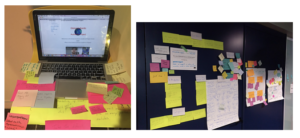
I had the great honor of collaborating with fellow innovative educational leaders this October, as a member of Google’s #TOR16 Google Certified Innovator cohort. The experience, held at Google’s Toronto headquarters, not only provided the opportunity to collaborate with a diverse group of forward thinking educators from across the globe, but it also allowed me to experience the design thinking process firsthand. I entered Toronto with a vision, to build capacity of site leaders through virtual, collaborative networks, as seen in the video below.
The Google Toronto Innovation Academy, with its series of “sparks” to spur ideation, and “sprints” to provide intense but flexible work-time, allowed me to crystallize the vision. These design thinking processes provided structures that are applicable to classrooms, educator team meetings, and collaborative networks, as they foster divergent thinking, collaboration, formative feedback, and continuous improvement. Before arriving in Toronto for the Innovation Academy, each member of our cohort created vision slidedecks in Google Slides. We collaborated regarding logistics using Google Hangouts, Google Groups, Google Maps, Google Docs, and Google Sites. I both provided and received formative feedback on empathy maps via comments feature of Google Drawings and vision slidedecks in Google Slides. Technology fostered this collaboration before any of us met IRL (in real life). IRL collaboration, using design thinking processes, proved to be especially effective. We began our time with a focus on the “end-user”, those stakeholders affected by our vision projects. After spending time analyzing these stakeholders’ needs, we worked to “turn your problem into an opportunity”. This places a positive, forward thinking spin on the work and creates momentum. We framed our work with the sentence frame, “How might we…?” This sentence starter promotes inquiry and frames the mind for creative solutions.

At each step of the way, we provided formative feedback to each other via post-it notes, stick-dots, and conversations. Imagine the power of using this framework in the classroom, to encourage students to think critically, communicate, collaborate, and come up with creative solutions to problems based on the needs of stakeholders.

Perhaps the most memorable and applicable process used at Google’s Toronto Innovation Academy for me, was “Crazy 8s”. This strategy for divergent thinking leads to ideation driven by time limits. Constraints increase creativity, and the strategy’s requirement of sketching 8 ideas in only 40 seconds each leads to innovative, atypical solutions. I have since used this process in network meetings, professional development sessions, and in my own creative work upon returning to my role as an EdTech Integration Consultant for Tulare County. While the strategy employs the use of paper rather than devices, it has proven to be effective in promoting divergent thinking for ideation of innovative EdTech solutions that meet the needs of stakeholders.

It is a mix of high tech and low tech tools that is most effective. As we plan professional development, staff meetings, classroom activities, etc, we must remember that technology is a tool that can accelerate our goals. It is not an end goal itself.
Divergent thinking in education, whether in the classroom, staff room, or board room, must be not only fostered but valued. This requires that we celebrate the variability and individuality of ALL stakeholders. As such, we affirm ideation by encouraging choice and voice. At the Innovation Academy, cohort member prototypes reflected individuality and creativity. Vision prototypes came in a mix of high tech and low tech representations. In your classroom, staff meetings, or professional development, do you allow your learners choice and voice? Are your learners given options to create innovative designs that empower them to own the work? #TOR16 cohort member prototypes came in the form of videos, sketchnotes, storyboards, websites, and more.

Allow for divergent thinking. Encourage individuality and creative ideation. It is only through voice and choice that we will continue to iterate toward innovative solutions.
